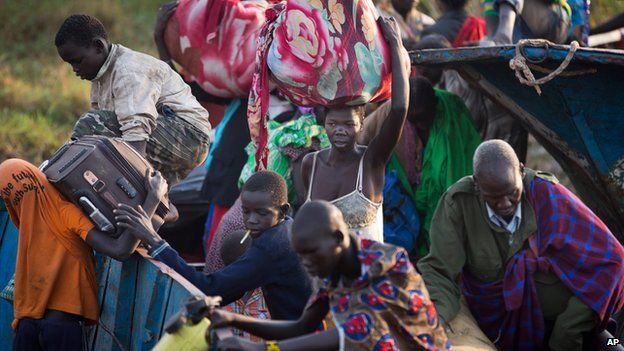South Sudan: Finding shelter by the Nile
- Published

The tens of thousands of people who fled Bor town and crossed the Nile dragging what few possessions they could carry, landed in Awerial county and found the nearest tree to set up camp.
Now, for miles along the river bank, every tree is taken. A small town has been overwhelmed by a deluge of people without food, clean water or sanitation.
There are just a handful of wells. Most people are collecting dirty, muddy river water for cleaning, cooking and drinking.
In a country where cholera is endemic, the risk of disease is high, and the two small Doctors Without Borders (MSF) clinics are already overwhelmed.
In one corner a baby lies motionless with its mother - a drip trying to rehydrate the child.
Others cry as their parents queue, waiting for a share of a dwindling supply of pills that might help save their lives.
Alistair Leithead reports from Awerial refugee camp on the banks of the Nile, now home to 75,000 people
Doctors say diarrhoea is the biggest problem at the moment and, until large supplies of water can be chlorinated, things will only deteriorate.
Food is also a challenge. But although there are probably more than 75,000 people whose supplies are running out, the queues for rations are orderly - those most in need are being provided for first.
While the international community scrambles to get aid from the capital Juba up the poor, pot-holed dirt road to Awerial, the situation in Bor is increasingly tense.
The long, deep boats that transported the people 150 at a time can no longer operate because it is too dangerous.
We met a woman and her daughter who were injured by shrapnel while trying to cross and there is much confusion surrounding what may be happening across the river.
Those in the camp say there are many more who would like to reach the safety of the western bank of the Nile.
But the rebels still control Bor and government forces appear to be mobilising, perhaps to attempt to take back the town.
Those who fled the town are predominantly from the Dinka community - the largest in South Sudan and the ethnic group of the president.
The man who is said to have attempted, or to have been planning, a coup which started this crisis is Riek Machar, who was vice-president until he was sacked in July.
He is from the second largest group, the Nuer, and what started out as a political crisis has sparked some ethnic violence.
The older people remember 1991 when Riek Machar last split from the then Sudanese rebel movement. That sparked fighting on ethnic lines which resulted in the massacre of 2,000 people in Bor.
Toby Lanzer, UN mission in S Sudan: "Situation continues to be very very volatile"
This latest political split has again provoked ethnic violence through a Nuer youth militia dubbed the "white army".
When the militia arrived in Bor, the Dinka desperately fled across the river. Some of those we spoke to in the camp said civilians were deliberately being targeted - and there were many bodies lying in the streets.
It is hard to confirm these reports, but there is a real fear in the camp that Dinka people would be killed if they returned to a rebel-controlled Bor.
Although much of the centre is said to be abandoned, many people fled into the bush - they are in need of help but out of reach.
Tens of thousands displaced by the fighting have also taken shelter in United Nations' compounds.
With aid flights unable to operate when there is a risk of renewed violence, the situation there is increasingly difficult.
Tonnes of aid is arriving, along with international organisations, who are trying to get help to those most in need.
The spontaneous town which has grown up along the Nile is the main focus of humanitarian efforts right now.
But more than 200,000 people have been displaced across the country, and if the fighting is to continue or intensify, more will be forced to flee their homes and become increasingly dependent on aid.